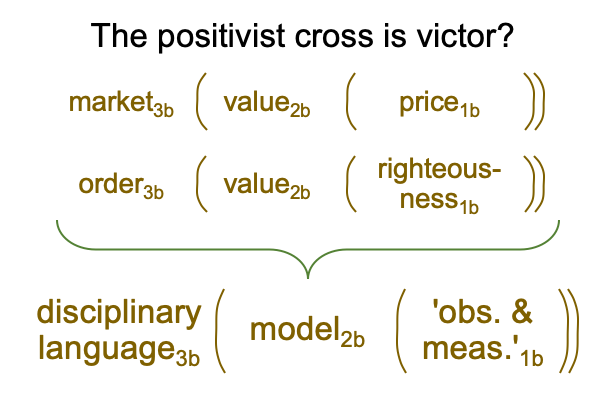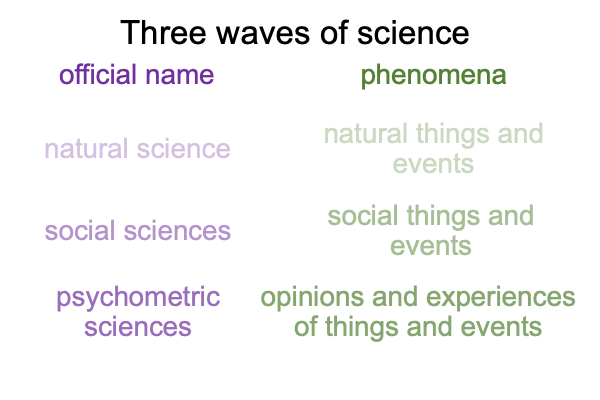Looking at Steve Fuller’s Book (2020) “A Player’s Guide to the Post-Truth Condition” (Part 8 of 26)
0068 Chapter four is wonderful. Fuller’s prose carries the reader on a rollercoaster of ideas, where each sudden twist and change of direction leaves unexplored territory. I wonder, “What would Fuller say, had he not fashioned a turn at that particular moment?” Further exploration is suspended. But, I retain a snapshot of the Count Saint-Simon turn, and it looks like this.

How do capitalist and socialist ones3c exclude one another?
Each dwells within its own questionable box.
Inside its respective box, each conjures its own expertise.
0069 On the cover of Fuller’s small paperback, a drawing of the head of a rabbit (or is it a duck?) appears. Well, if I see the drawing as a rabbit, then the figure is a rabbit. If I see the drawing as a duck, then the figure is a duck.
Taking the word, “value2b“, in the preceding figure, as the drawing, then the normal contexts of market3b and order3b are like gestalt recognitions for their respective potentials, price1b (which, to me, is like a rabbit) and righteousness1b (which, to me, is like a duck). And if what is inside the questionable box changes, so does the box.
0070 Does that mean that the forty-year conflict, The Third Battle Among The Enlightenment Gods, The Cold War Between Materialist Ideologies (1945-1989 AD) can be reduced to a contest between The Packaging of the Rabbit and The Packaging of the Duck?
According to the nature of gestalts, opportunity1c resides in fixating on one or the other party, because that leads to an actionable judgment2c, which is the very definition of success2c to the relativist one3c, who really does not care whether it carries the banner of the rabbit or the duck, as long as it3c is the one who is in charge of actualizing the judgment2c.
0071 At this point, I return to the two elements that stand outside the questionable boxes of capitalism and socialism.
Success2c and diverse facts and claims2a are the two elements for capitalism that are not built into the box of questionability.

0072 In the capitalist game, success is capital2b defined, in the old fashioned way, as “money” (however one wants to define the word, “money”). That is not questionable, is it?
Those with money2c aim to use that money to obtain more money2c. In this regards, money2c defines the capitalist2c. On the crappy-player level, people ask, “What do I need to do to earn a living?” What is a living? Well, it is certainly not absolute devotion to money, that is for sure. Life is all about adventures and friends and romance and babies and growing old and dying nobly. How do you put a price on that?
Can I sell you simulated versions of these items?
0073 So, how am I supposed to make a living?
This question does not concern the elements that compose the questionable box. This question concerns my participation in capitalism. I am within a post-truth game, trying to make my way.
The employment of capital2c by those with capital2c is like an interventional sign-vehicle (SVi) that cannot be directly witnessed by any scrappy player, except in so far as it manifests as action. Action implies that a judgment has been made. Look in the want ads. Look what other people are doing. I hear that someone is hiring down the street. To the scrappy player, that judgment2c stands for a pursuit of success2a, a project2a or something to do2a, that defines “success2a” as getting ahead (that is, making a good living) (SOi), according to the intellect3a operating on the will1a (and remember that reason is the employment of intellect3a and will1a) (SIi).

0074 Uh-oh. Am I suddenly talking about sign-relations?
A sign-vehicle (SV) stands for a sign-object (SO) in regards to a sign-interpretant (SI).
The interventional sign-relation is counterintuitive, to say the least.
0075 The interventional sign vehicle (SVi) is an actionable judgment2c (capital is put into action) that stands for opinions about what I need to do2a (SOi) in regards to the intellect3a operating on the will1a (SIi).
I may ask the opinions of others2a (SOi). I may have my own opinions2a (SOi). Furthermore, I can discern the intellects3a and wills1a (SIi) of myself and those around me. But, I cannot actually see the sign-vehicle (SVi), because it2cresides on the perspective level. It is as if…
The interventional sign-vehicle (SVi) dwells inside someone’s head. It is mind-dependent.
But, it2c (SVi) is mind-independent as well.
A judgment2c leads to actions (SVi), and because these actions become the source of various opinions, the interventional sign-object (SOi) comes into being through the working of people’s reason3a,1a (SIi). These opinions2a (SOi) are about the possibility of ‘something happening’1a in the normal context of what is happening3a (SIi). These opinions2a frame perceptions based on imagination working with the question, “What does this mean to me?”. And, sometimes, these opinions2a will weigh one’s impressions and one’s perceptions, while asking, “Does this make sense?”
I suppose that this is the way that humans think.
What is happening (SIi1)?
What does it mean to me (SIi2)?
Does this make sense (SIi3)?
0076 Overall, the interventional sign-relation is the inverse of how a sign-relation ought to be.
For familiar sign-relations, the sign-vehicle is mind-independent and its sign-object is mind-dependent.
Here is an example of a specifying sign-relation. The expert says that opinions about what people think that they need to do2a (SVs) stands for value2b (SOs) in regards to the market3b operating on the potential of pricing1b (SIs).
0077 Here is a picture of a capitalist expert’s specifying sign-relation.

Note how the specifying sign-vehicle (SVs) is mind-independent phenomena (what people say2a) of a mind-dependent noumenon (SOi) (what people think2a).

























